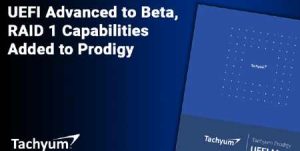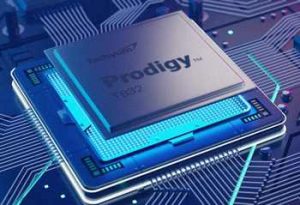Tachyum Moves UEFI to Beta and Adds RAID-1 Capabilities to Prodigy
RAID’s ability to store data across multiple HDDs or SSDs allows for protection of data in case of drive failure by creating redundancy and improving performance.
This is a Press Release edited by StorageNewsletter.com on May 24, 2024 at 2:01 pmTachyum, Inc. has advanced the Unified Extensible Firmware Interface (UEFI) to beta and has added RAID-1 capabilities.
These latest improvements are a further indication that the firm’s Prodigy hardware continues to mature through its development stages prior to its public release.
UEFI replaces the traditional BIOS as a next-gen interface between the OS and platform firmware. It is used during startup to initialize the hardware and load the OS. Additionally, UEFI determines device boot priority and allows users to customize hardware and software settings. With this latest release, menus and submenus, screens and options received upgrades for better functionality and an improved user experience.
In conjunction with the advancement to beta, the company released a user manual that provides details about how to access and use the UEFI, which is embedded in the system flash on all Prodigy platforms. The manual explains each of the UEFI menus, how to configure UEFI parameters and how to save new configurations. The documents are intended for users who install, maintain, troubleshoot and administer Prodigy platforms.
RAID’s ability to store data across multiple HDDs or SSDs allows for the protection of data in case of a drive failure by creating redundancy and improving performance.
Tachyum’s approach to this virtual disk technology provides:
- RAID-1 boot for preinstalled Linux partition with preinstalled software
- RAID-1 read-only partition for installation packages and to restore images to the manufacturing original state if the customer runs into problems
- Partition where customers can install and configure their own Linux and apps configured by them
- RAID-0 for data
“We continue to see impressive advancements in the capabilities and functionality of Prodigy at every level of development,” said Dr. Radoslav Danilak, founder and CEO. “Moving UEFI from alpha to beta allows a better look and polishing of the UEFI. RAID-1 was added to provide a RAID boot without the need for expensive NVMe SSD RAID cards, helping to bring Prodigy-enabled systems to datacenter-level class. All of these moves, including the expectation that we will have a release candidate available next quarter, further signifies that we are nearing production of the Prodigy Universal Processor.”
As a Universal Processor offering performance for all workloads, Prodigy-powered data center servers can dynamically switch between computational domains (such as AI/ML, HPC, and cloud) with a single homogeneous architecture. By eliminating the need for expensive dedicated AI hardware and increasing server utilization, Prodigy reduces Capex and Opex while delivering data center performance, power, and economics. It integrates 192 high-performance custom-designed 64-bit compute cores, to deliver up to 4.5x the performance of the highest-performing x86 processors for cloud workloads, up to 3x that of the highest performing GPU for HPC, and 6x for AI applications.
Resource:
Video demonstration of RAID 1 UEFI boot on Prodigy emulation system is available for viewing
















 Subscribe to our free daily newsletter
Subscribe to our free daily newsletter

